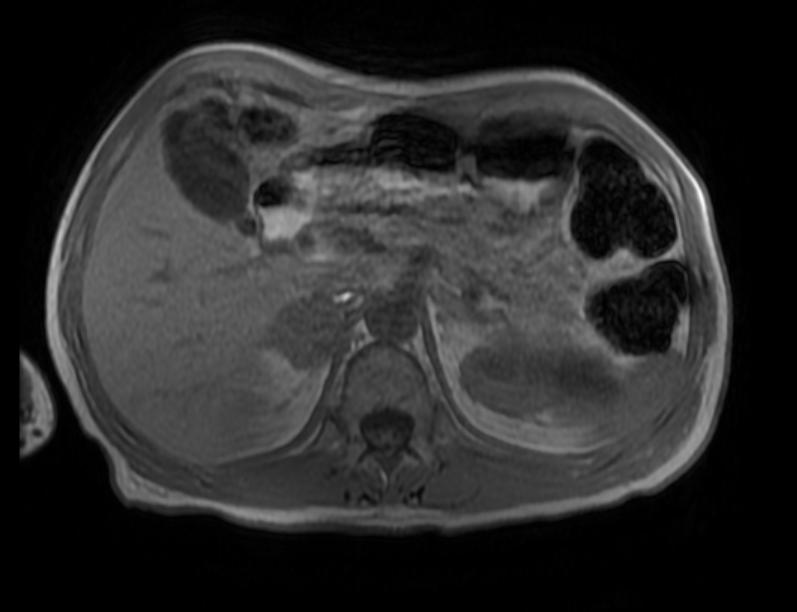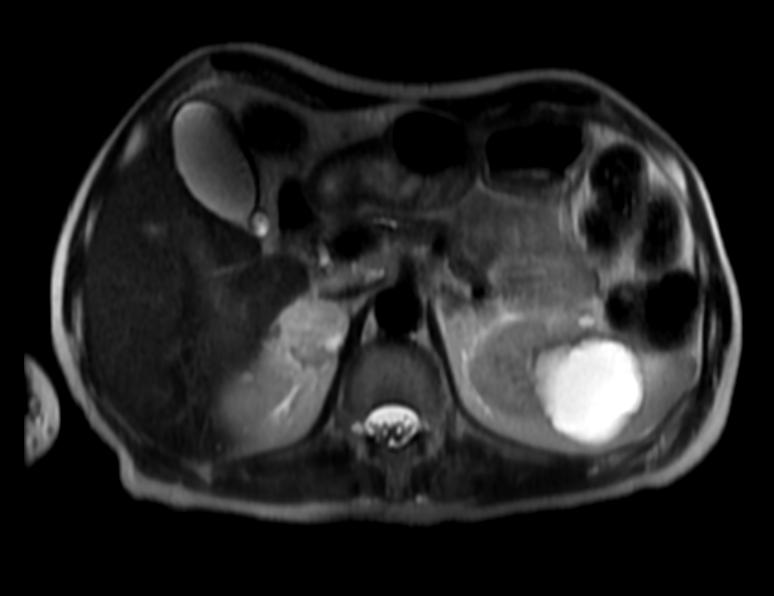Pheochromocytoma MRI: Difference between revisions
Jump to navigation
Jump to search
Irfan Dotani (talk | contribs) No edit summary |
|||
| Line 9: | Line 9: | ||
==Key MRI Findings in Pheochromocytoma== | ==Key MRI Findings in Pheochromocytoma== | ||
Key [[MRI]] findings in pheochromocytoma are:<ref name="radio">Pheochromocytoma. Dr Matt A. Morgan and Dr Frank Gaillard Gold Supporter since June 24, 2015">. Radiopaedia.org 2015.Page http://radiopaedia.org/articles/pheochromocytoma-2</ref><ref name="pmid8076587">{{cite journal| author=Bravo EL| title=Evolving concepts in the pathophysiology, diagnosis, and treatment of pheochromocytoma. | journal=Endocr Rev | year= 1994 | volume= 15 | issue= 3 | pages= 356-68 | pmid=8076587 | doi=10.1210/edrv-15-3-356 | pmc= | url=https://www.ncbi.nlm.nih.gov/entrez/eutils/elink.fcgi?dbfrom=pubmed&tool=sumsearch.org/cite&retmode=ref&cmd=prlinks&id=8076587 }}</ref> | |||
:*T1 slightly hypointense to the remainder of the adrenal gland, if there is a necrosis and/or haemorrhage then the signal will be more heterogeneous | :* T1 slightly hypointense to the remainder of the adrenal gland, if there is a necrosis and/or haemorrhage then the signal will be more heterogeneous. | ||
:*T2 markedly hyperintense | :* T2 markedly hyperintense '''lightbulb sign''', helpful in the diagnosis, areas of necrosis/haemorrhage/calcification will alter signal. other adrenal tumors isointense such as liver. | ||
:*T1 C+ (Gd) heterogenous enhancement is prolonged, persisting for as long as 50 | :* T1 C+ (Gd) heterogenous enhancement is prolonged, persisting for as long as 50 minute | ||
*[[Spin-spin relaxation time|T2]] weighted MRI of the [[head]], [[neck]], and [[chest]], and [[abdomen]] can help localize the tumor | :* Increased attenuation on nonenhanced CT (>20 Hounsfield units. | ||
:* Variable mass size and vascularity and may be bilateral. | |||
:* [[Spin-spin relaxation time|T2]] weighted MRI of the [[head]], [[neck]], and [[chest]], and [[abdomen]] can help localize the tumor. | |||
'''Patient #1: Bladder pheochromocytoma''' | '''Patient #1: Bladder pheochromocytoma''' | ||
Revision as of 15:40, 3 July 2017
|
Pheochromocytoma Microchapters |
|
Diagnosis |
|---|
|
Treatment |
|
Case Studies |
|
Pheochromocytoma MRI On the Web |
|
American Roentgen Ray Society Images of Pheochromocytoma MRI |
Editor-In-Chief: C. Michael Gibson, M.S., M.D. [1]; Associate Editor(s)-in-Chief: Ahmad Al Maradni, M.D. [2]
Please help WikiDoc by adding content here. It's easy! Click here to learn about editing.
Overview
Head, neck, chest, and abdominal MRI may be helpful in the diagnosis of pheochromocytoma.
Key MRI Findings in Pheochromocytoma
Key MRI findings in pheochromocytoma are:[1][2]
- T1 slightly hypointense to the remainder of the adrenal gland, if there is a necrosis and/or haemorrhage then the signal will be more heterogeneous.
- T2 markedly hyperintense lightbulb sign, helpful in the diagnosis, areas of necrosis/haemorrhage/calcification will alter signal. other adrenal tumors isointense such as liver.
- T1 C+ (Gd) heterogenous enhancement is prolonged, persisting for as long as 50 minute
- Increased attenuation on nonenhanced CT (>20 Hounsfield units.
- Variable mass size and vascularity and may be bilateral.
- T2 weighted MRI of the head, neck, and chest, and abdomen can help localize the tumor.
Patient #1: Bladder pheochromocytoma
Patient #2: Abdominal pheochromocytoma
References
- ↑ Pheochromocytoma. Dr Matt A. Morgan and Dr Frank Gaillard Gold Supporter since June 24, 2015">. Radiopaedia.org 2015.Page http://radiopaedia.org/articles/pheochromocytoma-2
- ↑ Bravo EL (1994). "Evolving concepts in the pathophysiology, diagnosis, and treatment of pheochromocytoma". Endocr Rev. 15 (3): 356–68. doi:10.1210/edrv-15-3-356. PMID 8076587.








